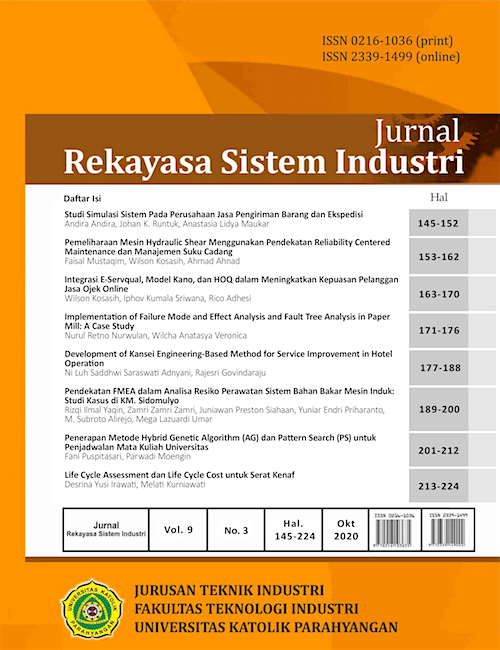Implementation of Failure Mode and Effect Analysis and Fault Tree Analysis in Paper Mill: A Case Study
DOI:
https://doi.org/10.26593/jrsi.v9i3.4059.171-176Abstract
A good quality control system is important to be implemented to increase productivity and minimize defects in products. One of the quality control methods is failure mode and effect analysis (FMEA). This study uses the FMEA to identify the causes of the defects and recommend the prevention methods to overcome the causes of the defects in an Indonesian paper mill. The risk priority number (RPN) is calculated by multiplying the severity, occurrence, and detection of the failures that have been determined. Unsymmetrical and tainted products are the most dominant defects in the paper mill. An inappropriate machine setting is the cause of unsymmetrical products with the highest RPN of 343. The second highest RPN is problems with bleaching machines that caused tainted products with an RPN value of 216. This study offers suggestions to Indonesian paper mill to prevent and minimize defective products.
References
Dudek-Burlikowska, M. (2011). Application of FMEA method in enterprise focused on quality. Journal of Achievements in Materials and Manufacturing Engineering, 45(1), 89–102.
Gaspersz, V. (2003). Total Quality Management (TQM). Jakarta: PT. Gramedia Pustaka Utama.
ISO. ISO 9001. (2008). Quality Management Systems. Requirements.
Jia, H., Li, Z., & Liu, H.C. (2017). New approach for failure mode and effect analysis using linguistic distribution assessments and TODIM method. Reliability Engineering and System Safety, 167, 302-309.
Liu, H.C., You, J.X., Li, P., & Su, Q. (2016). Failure mode and effect analysis under uncertainty: An integrated multiple criteria decision making approach. IEEE Transactions on Reliability, 65(3), 1380-1392.
Liu, H.C., You, X.Y., Tsung, F., & Ji, P. (2018). An improved approach for failure mode and effect analysis involving large group of experts: An application to the healthcare field. Quality Engineering, 30(4), 762-775.
Lo, H.W., Liou, J.J.H., Huang, C.N., & Chuang, Y.C. (2018). A novel failure mode and effect analysis model for machine tool risk analysis. Reliability Engineering and System Safety, 183, 173-183.
Mandavgade, N.K., & Jaju, S.B. (2009). Optimization of cost by using 7 QC tools. International Journal of Engineering Studies, 1, 149-160.
Mhetre, R. S., & Dhake, R. J. (2012). Using failure mode effect analysis in a precision sheet metal parts manufacturing company. International Journal of Applied Science and Engineering Research, 1(2), 302–311.
Montgomery, D. C. (2009). Introduction to Statistical Quality Control. Danvers, MA: John Wiley and Sons, Inc.
Parsana, T. S., & Patel, M. T. (2014). A case study: A process FMEA tool to enhance quality and efficiency of manufacturing industry. Bonfring International Journal of Industrial Engineering and Management Science, 45(3), 145–148.
Whiteley, M., Dunnet, S., & Jackson, L. (2015). Failure mode and effect analysis, and fault tree analysis of polymer electrolyte membrane fuel cells. International Journal of Hydrogen Energy, 41(2), 1187-1202.
Xi, L.F. & Xu, G. (2002). The application of FMEA in process management. Journal of Industrial Engineering and Management, 1, 37-39.
Zhang, H., Dong, Y., Palomares-Carrascosa, I., & Zhou, H. (2019). Failure mode and effect analysis in linguistic context: A consensus-based multiattribute group decision-making approach. IEEE Transactions on Reliability, 68(2), 566-582.

